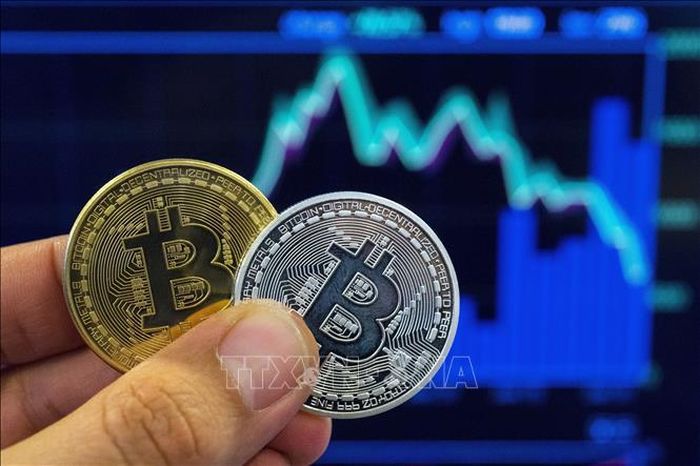US stocks recovered, oil prices extended their decline

Closing the session on April 22, the Dow Jones industrial average increased 253.58 points (+0.67%) to 38,239.98 points, the S&P 500 added 43.37 points (+0.87%) to 5,010, 60 points and Nasdaq Composite climbed 169.30 points (+1.11%) to 15,451.31 points.
All 11 S&P 500 sectors closed higher, with technology and financials leading gains.
Megacap growth stocks all finished higher, with gains ranging from 0.5% to 1.5% in Alphabet, Amazon.com and Apple.
Nvidia rose 4.4%, recovering from a 10% decline in the previous session.
Meanwhile, Tesla shares fell 3.4% as the electric vehicle maker cut prices on its products in several major markets, including China and Germany, following sharp price cuts in the US.
Cardinal Health lost 5% on news that the contract with UnitedHealth Group - one of the company's largest customers - will not be renewed beyond next June.
Trading volume on US stock exchanges was 10.33 billion shares, lower than the average of 11.03 billion shares in the past 20 days.
This week, the market is preparing for quarterly results from large-cap companies, including some of 'The Magnificent Seven' such as Tesla, Meta Platforms, Alphabet and Microsoft.
In addition to top corporate earnings, the market is also awaiting the release of March personal consumption expenditures (PCE) data - the Fed's preferred inflation measure - to further determine the trajectory of monetary policy bad.
The benchmarks S&P 500 and Nasdaq recovered from declines over the past six sessions as investors reassessed their expectations for interest rate cuts, following a series of strong economic data, tensions geopolitical tensions, persistent inflation and comments from officials of the US Federal Reserve (Fed).
According to LSEG data, the market is currently only pricing in about 0.41 percentage points of interest rate cuts this year, well below expectations of 1.5 percentage points seen at the beginning of the year.
Fed policymakers are on a media blackout ahead of their policy meeting on May 1.
In the energy market, oil prices fell to lower levels on April 22, extending last week's decline as concerns about an Iran-Israel escalation eased.
Brent oil futures fell 0.3% to 87.00 USD/barrel, while WTI oil inched up 0.04% to 82.85 USD/barrel.
Both contracts fell more than 3% last week on concerns about weakening demand amid weak global economic conditions. This reason has partly compensated for the tense situation in the Middle East.
Besides demand concerns, investors are also considering the outlook for US interest rates, which are likely to remain high for a longer period of time and thereby directly affect economic growth. . However, some say demand will still improve heading into the US summer.
'With oil demand increasing seasonally, we continue to see a supply shortage in the market. We aim to increase Brent oil prices to 91 USD/barrel by the middle of this year,' UBS wrote in a note.
The latest data from Baker Hughes shows that US oil drillers increased the number of drilling rigs by 5 rigs last week to 511 rigs. This is the highest number of active oil rigs since September 2023 when WTI prices traded above $90/barrel for many sessions, ING noted.
In crypto markets, last weekend's Bitcoin Halving event has so far had little impact on Bitcoin prices, with industry insiders saying that the fortunes of cryptocurrencies are now more closely tied to market sentiment. financial market and the broader geopolitical situation.
Bitcoin enthusiasts have been eagerly awaiting the "Halving" event - a change to the underlying technology of the cryptocurrency and designed to reduce the rate at which new Bitcoin is created. This event usually takes place. every four years, and analysts have previously provided past examples showing that post-halving price recovery is a positive sign for Bitcoin price in the medium term.
However, as of the evening of April 22, there was still little discernible impact on Bitcoin, with trading around $66,300. Bitcoin was up 1.2% last week and up 3.4% on Monday, but overall has been struggling to find new direction since hitting an all-time high of $73,794 last month. .
The CEO of Austrian crypto brokerage Bitpanda, Eric Demuth, said Bitcoin is increasingly dependent on broader market sentiment and there is no clear pattern of retail trading activity around the clock. around the Halving event. 'Cryptocurrencies are behaving very similarly to stocks. Because stock traders and the technology industry are also participating in cryptocurrencies a lot,' Mr. Demuth assessed.
You should read it
- Bitcoin finds its heyday
- Crossing virtual walls, Bitcoin exploded in real life
- Bitcoin broke $40,000, the market capitalization of the entire cryptocurrency market lost $2 trillion
- Dell accepts payments with Bitcoin
- Supply reduced by half, how 'chaotic' will the bitcoin market be?
- From Bitcoin to Dogecoin, both rebounded strongly, the cryptocurrency market exceeded 2 trillion USD in market capitalization
- Crash warning: Bitcoin plummets, cryptocurrency market 'on fire'
- How to dig bitcoin without wasting electricity
May be interested
- Notebook computer prices will increase
 the first alliance of laptop manufacturers including hewlett-packard (hp), lenovo and acer has just agreed to raise prices for original equipment manufacturers (oems).
the first alliance of laptop manufacturers including hewlett-packard (hp), lenovo and acer has just agreed to raise prices for original equipment manufacturers (oems). - Actual photo of iPhone 11, 11 Pro and 11 Pro Max, expected price in Vietnam from 21.99 million
 apple has launched a series of iphone 2019 products including iphone 11, iphone 11 pro and iphone 11 pro max this morning in vietnam time.
apple has launched a series of iphone 2019 products including iphone 11, iphone 11 pro and iphone 11 pro max this morning in vietnam time. - The price of RAM is very low, this is a reasonable time for you to upgrade your PC
 the current price of ram has dropped by half, perhaps this is the lowest level in many years. what's happening?
the current price of ram has dropped by half, perhaps this is the lowest level in many years. what's happening? - Why is the price of bitcoin so high?
 the price of bitcoin has risen to more than $ 17,500, breaking all previous records of bitcoin prices. but why is this virtual currency so valuable?
the price of bitcoin has risen to more than $ 17,500, breaking all previous records of bitcoin prices. but why is this virtual currency so valuable? - Price list of new iPhones, current latest iPhone prices
 this is the iphone price list, including the new iphone price list and 99% old iphone price list. prices of old iphones here will vary depending on the warranty policy, after-sales policy of each store
this is the iphone price list, including the new iphone price list and 99% old iphone price list. prices of old iphones here will vary depending on the warranty policy, after-sales policy of each store - Apple lowered the price of iPhone XS and XS Max at the store
 apple decided to `` kill '' the iphone xs and xs max launched last year on the website, while reducing the prices for these two devices.
apple decided to `` kill '' the iphone xs and xs max launched last year on the website, while reducing the prices for these two devices. - Microsoft announces pricing for Windows 10 extended security updates
 microsoft is currently offering an extended security program (esu), which allows the system to still receive additional updates after the operating system ends support.
microsoft is currently offering an extended security program (esu), which allows the system to still receive additional updates after the operating system ends support. - Use extended mouse buttons to increase efficiency
 make a habit of using functionally assigned extended mouse buttons, at which point you'll see how amazing it is in everyday activities with your computer.
make a habit of using functionally assigned extended mouse buttons, at which point you'll see how amazing it is in everyday activities with your computer. - Why is the configuration no longer important to laptops?
 not long ago, i talked to you about the decline in the importance of configuration in choosing laptops. of course, decline does not mean disappearing, configuration is still one of the factors when choosing.
not long ago, i talked to you about the decline in the importance of configuration in choosing laptops. of course, decline does not mean disappearing, configuration is still one of the factors when choosing. - SSD prices may decrease again later this year
 for much of 2023, solid-state drive (ssd) prices for pcs have fallen to record lows, making it difficult to upgrade gaming rigs, laptops, or other computers with ssds. becomes much cheaper.
for much of 2023, solid-state drive (ssd) prices for pcs have fallen to record lows, making it difficult to upgrade gaming rigs, laptops, or other computers with ssds. becomes much cheaper.










 When is the next Bitcoin halving?
When is the next Bitcoin halving? Police came to search the bungalow of 'poor former student', discovered a strange safe in the basement: 1 person was arrested, more than 50,000 stolen Bitcoins were recovered
Police came to search the bungalow of 'poor former student', discovered a strange safe in the basement: 1 person was arrested, more than 50,000 stolen Bitcoins were recovered Bitcoin price today April 21: Recovering to 65,150 USD
Bitcoin price today April 21: Recovering to 65,150 USD Bitcoin price today April 20: Slightly decreased trading around the 64,000 USD mark
Bitcoin price today April 20: Slightly decreased trading around the 64,000 USD mark Why is Bitcoin price unchanged after the historic 'split in two' event?
Why is Bitcoin price unchanged after the historic 'split in two' event? Bitcoin completes its fourth 'halving'
Bitcoin completes its fourth 'halving'